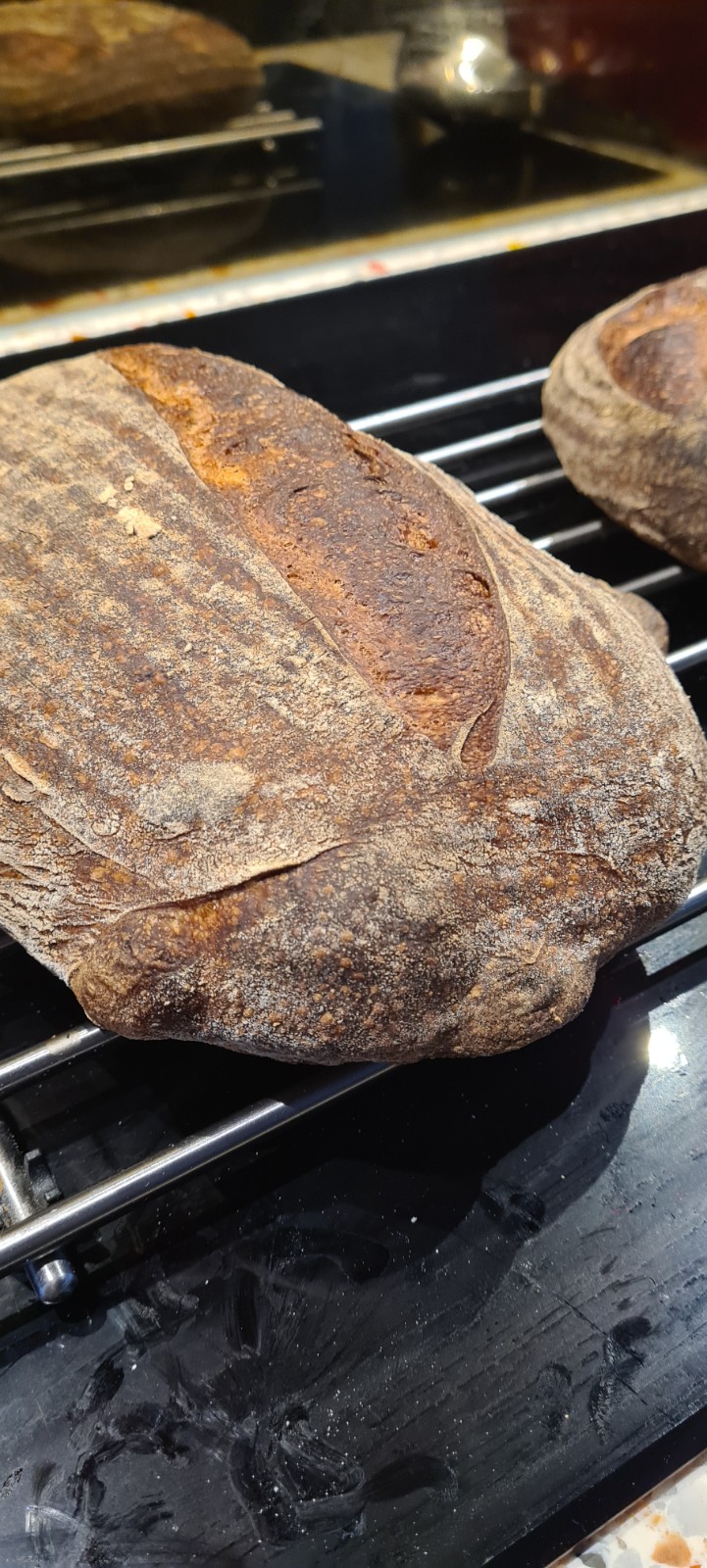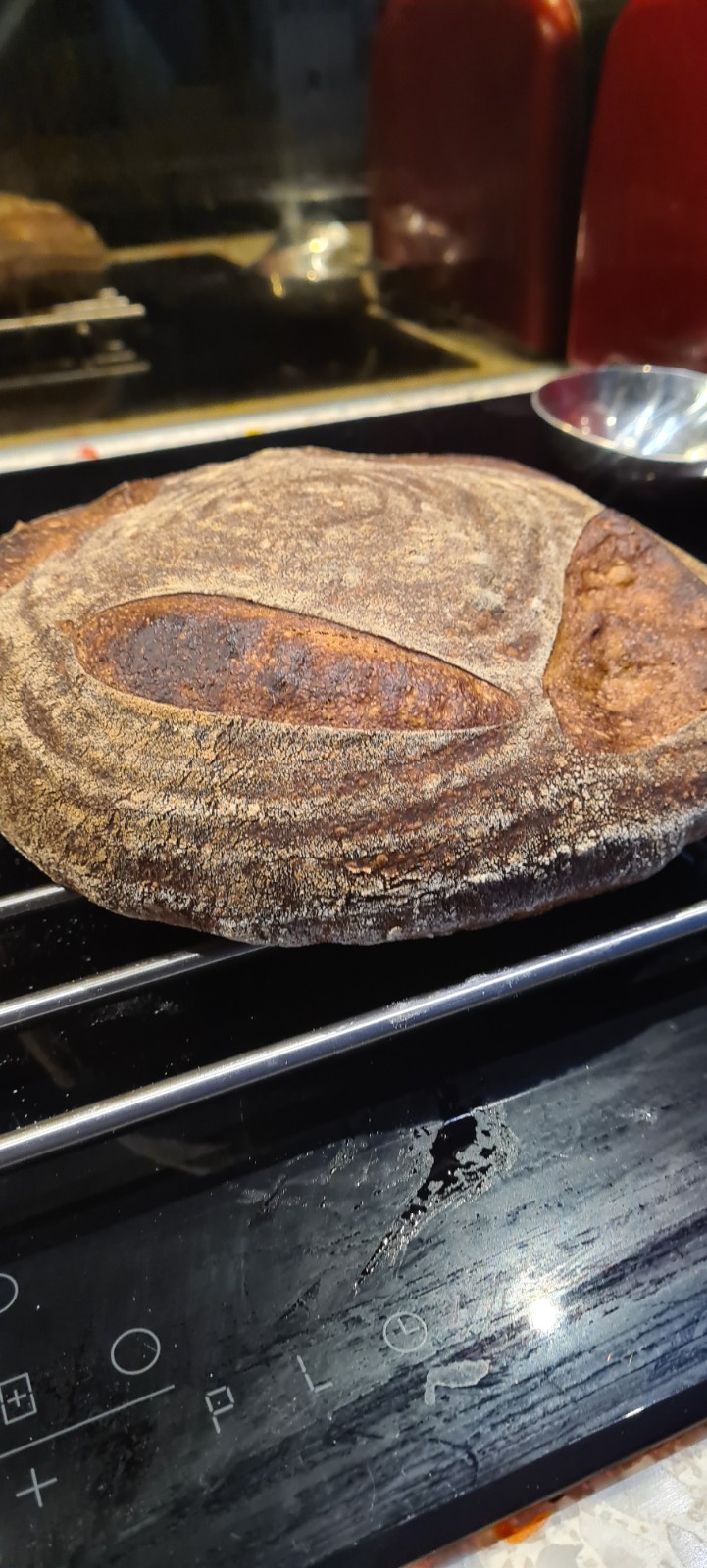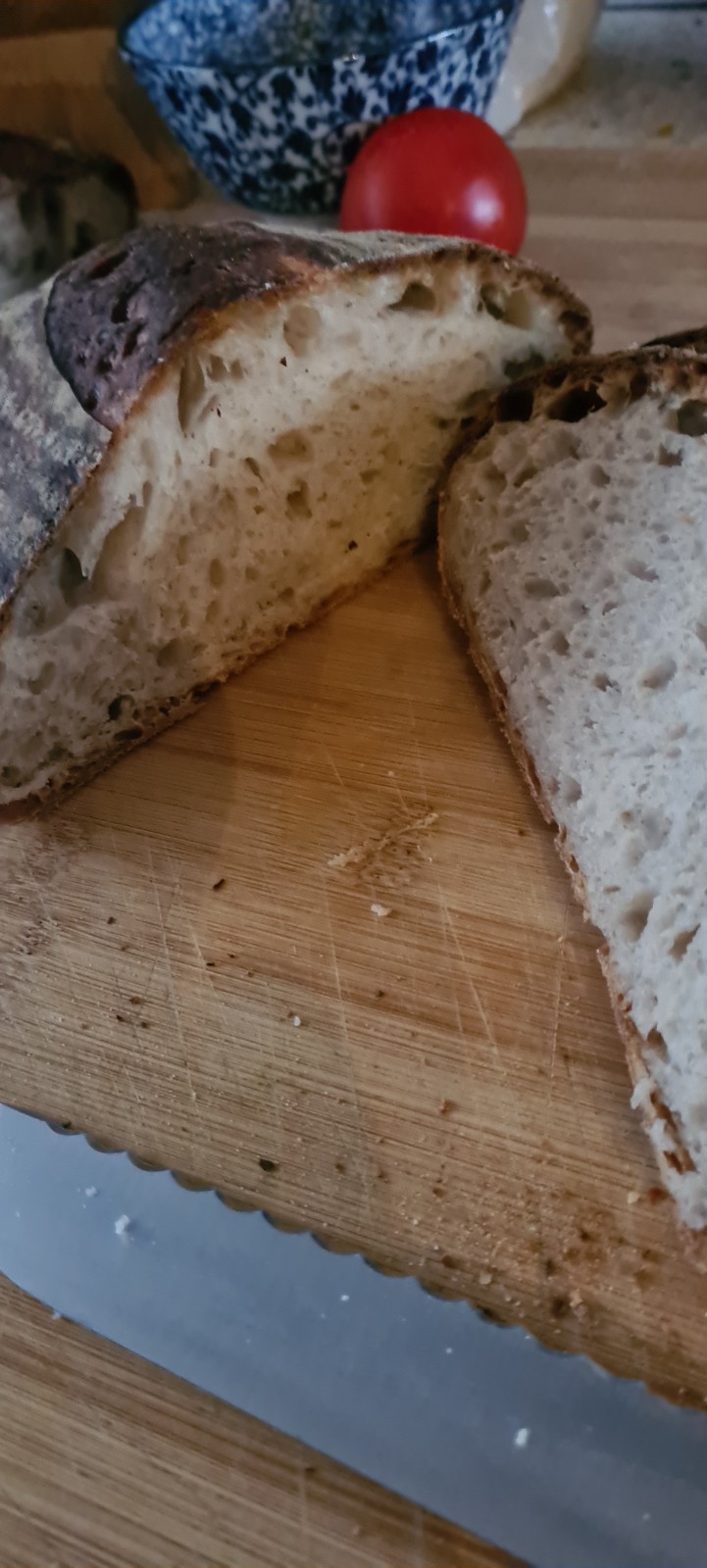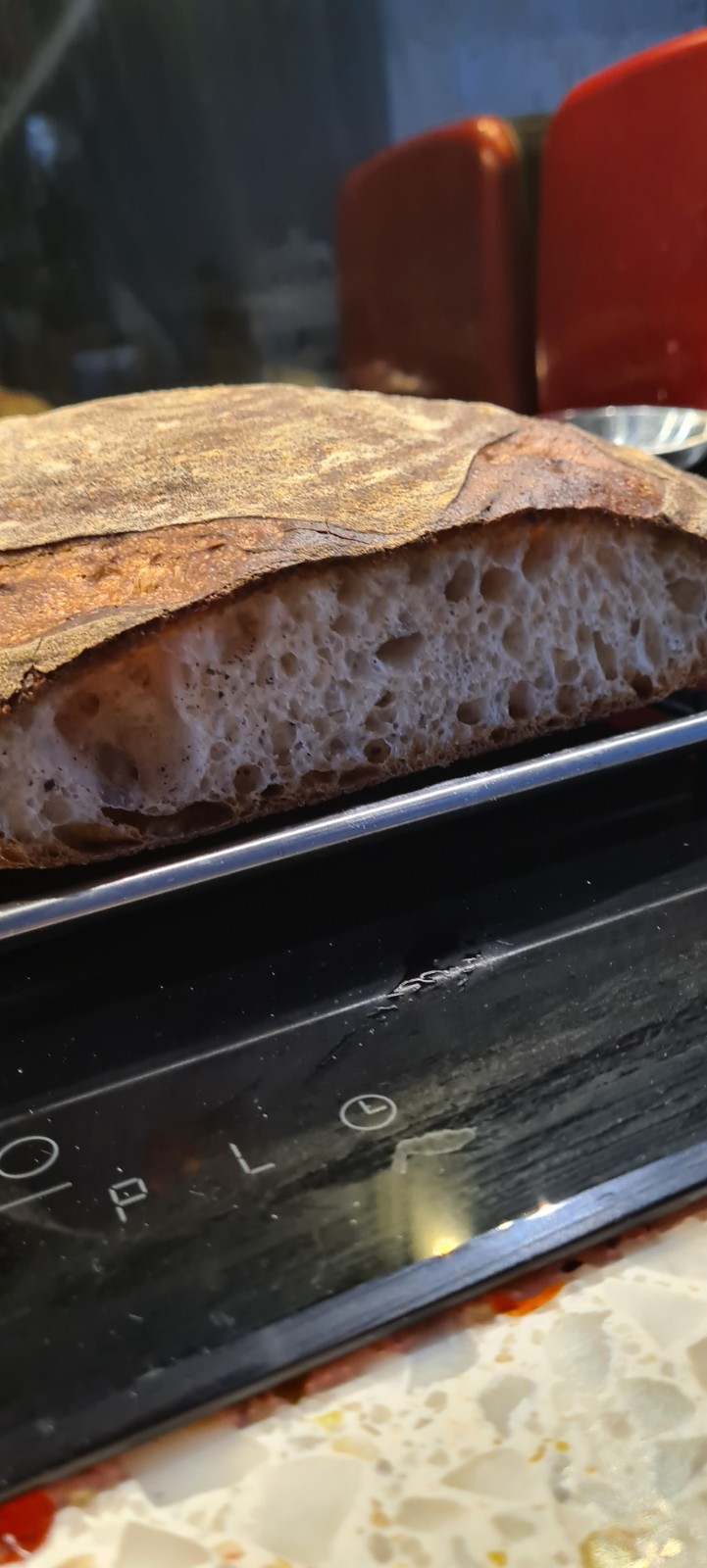Hello,
my quest for ears goes on. I have taken on board much of what has been helpfully advised on this wonderful forum but other than gaining experience and lots of tasty bread, I'm no nearer to the spring and ears I so desire.

The above is a 15% rye, 65% hydration loaf baked on a stone in an over with 'medium' humidity. The following picture is of a loaf made from exactly the same batch ferment...

I have been using an aliquot jar as advised to watch my bulk fermentation. This batch was roughly 75% risen. I turned it out and divided it in half to make two loaves and pre shaped. What I noticed immediately is that the top one kept its shape in the pre shape while the bottom one just sort of fell apart almost immediately. Can anyone explain that? One kept its structure, the other didn't, even though I shaped tightly to develop that strength.
I am taking my 100% starter straight from the fridge, adding 150g flour, 150g water and 100g starter, mixing and waiting until it's doubled in size. In a proving oven that takes about three or four hours. I then use it in the normal manner adding 200g starter to 800g flour and 480g water and mixing in a mixer until it's lovely and stretchy. I then place it in a bowl and stretch regularly until the aliquot jar tells me to pre shape (in this case it was a good 7 hours). The aliquot jar had risen about 75% at that point.
I pre shaped, shaped, put both loaves in bannetons and refrigerated overnight, turning out and baking in the morning. The bottom one came out flat as a pancake. The top one wasn't too bad but still no ears. I baked at 230 with humidity for 15 mins and then 220 without humidity for the remaining 25 mins.
I have tried lots of things in a bid to get the spring I want for the ears I want. I have tried high humidity. I have tried longer fermentation. I have tried shorter fermentation. I have tried higher and lower hydration loaves,
Is it that the dough isn't strong enough? Can you OVERwork a dough? Am I mixing it in my mixer too long? Or too short? It has a lovely stretch to it when it goes into bulk fermentation.
Its so weird to me how two loaves from the same bulk behaved in such different ways on pre shaping. How on earth? I'm at a loss.
The bread itself is delicious. And I'm fairly happy with the crumb. But I just don't know how to get consistent results with the spring. I have managed to get wonderful ears in the past but it's all luck I'm afraid. I thought the aliquot jar was the answer but watching my rise doesn't seem to make a difference. I suspect the loaves above were overproved but the aliquot jar said 75% which I gather is a good time to get pre-shaping. Here's the crumb...

And the crumb of the one that collapsed...

If you've come this far, thank you very much for your patience. Any help and guidance is greatly appreciated.
Overfermented. 7 hours plus overnight is too long.
What do you mean by "medium humidity"? Is your oven a steam oven? How are you managing humidity?
How are you developing gluten? You said "mixer". What does that mean? How long did you mix the dough?
I'm seeing scoring that is too shallow. For an ear to develop, the scored edge needs to be sufficiently large to pull away from the loaf and curl during baking. You need to score sufficiently deep to create a flap, which becomes an ear during baking. Scoring is tricky. I am far from mastering it. You need to be firm and more aggressive than you might first think. Try over scoring, meaning very deeply and nearly parallel to the outer skin. A visual for this is that you want to flay the skin off the loaf when scoring.
Separately, I'm seeing thick dark crust on the photos, particularly the flattened loaf. The loaves are 750g each, pre-bake weight, correct? Seems the time+temperature is a bit too much for the smallish loaf weight. I bake 1500g loaves for about 50-55 minutes at 450-475 deg F and the crust is not that thick or dark.
Thank you for taking the time to reply.
I suspect overfermenting too. However, I am using the aliquot jar method I learned on this very forum.
I believed that would take away the guesswork in the fermentation stage.
The two loaves I baked here, the aliquot jar was about 70% risen. I felt that was the optimum rise. But yes, it took a loooong time. usually the rise happens in three or four hours. I wondered whether the starter wasn't active enough. But my starter had risen 100% when I added it.
So I'm a bit at a loss if the aliquot jar can't guide me. Is 70% too much of a rise in the jar maybe? I'll try 50%.
On your other questions, I have started using a stand mixer because it gives me a beautifully silky dough with less effort. I have always mixed on the very slowest speed for fear of bashing the dough about but just recently I am mixing on speed 4 and I think it creates a silkier, stronger dough. Do you have any thoughts on the speed? I mix for roughly 10 mins and like I said I get a good elastic dough. In fact I do wonder if there's such a thing as overmixing.
As I type this I am starting to think the problem is definitely overfermentation because the dough that came out was lovely and elastic but when I went to preshape, one of the loaves just sort of collapsed and so I can't see another reason for that to happen, can you?
The aliquot jar is an indicator of how much fermentation has happened. However unless you don't know what you are looking for, it won't tell you when to stop. It's really helpful to nail down the right amount of fermentation after a few tries though! So indeed aim for less rise next time and see what happens. Just keep a good record and in the end you'll be able to ferment on point every time.
Hello Ilya,
would you say there's no set rule on the rise? Does it depend on the type of loaf etc? Do you think there's a minimum and a maximum rise? eg should I never go to preshape at less than 50% rise and never more than 100% rise in the aliquot jar? Is there a 'mean' time which will always deliver a decent rise?
Again, it puzzles me why a 75% rise took so long and also why it produced an overfermented loaf when lots of people say they wait for a 100% rise.
Any help gratefully received.
It depends on lots of things: type of flour, level of hydration, whether you are shaping the loaf or baking in a pan, etc. With a strong white flour perhaps 100% rise would work - but with weaker flours or with a significant % of whole grain it might be too much.
Most people rise "until double" - which means nothing, because they don't use a precise way to measure rise, and judging volume in a bowl is impossible. Moreover, overfermentation in bulk using commercial yeast is much less of a problem, since there is no excess acid production, and the gluten is still mostly intact, for a long time. Sourdough if much more sensitive to this though.
Benny has used the aliquot jar for a lot of different doughs now, he might be able to help you with more concrete ideas for different types of doughs. I more often use a straight sided container, which is less precise.
ah, when I say I use an aliquot jar, I, like you, am simply talking about a small straight sided container.
Is this not a precise method? Also, does the amount of dough I put in the jar matter? I use a small amount, say 50g.
I can't imagine why it would matter but now I'm wondering.
I use a typical strong white bread flour.
Do you think it's possible to get a false read off the jar? like if there's a big air bubble in it or something?
What I meant by a straight-sided container is putting the whole dough into one, not using a small aliquot to gauge the rise of the main dough. Which is less precise because in a large container the surface of the dough is very uneven, and a certain % rise results in a much smaller absolute rise in cm. But on the other hand, this method doesn't suffer from drawbacks of the aliquot jar that changing temperature affects the jar much faster than the main dough.
When putting the dough into an aliquot jar you have to make sure there are no big bubbles :) And I don't think the amount matters, as long as there is appreciable height of your dough in the particular jar you are using, so depends on the shape/size of the jar.
Semolina Man is correct. Over fermented…
You may find something(s) helpful in one or both of the following links.
If you are willing to bake another bread, THIS ONE has had a history of great successes among many bakers. The link will take you to a Community Bake that featured Kristen of FullProofBaking. There is a lot of good information in the multitude of replies to the original post.
I wish you well!
Some bakers are blessed and get ears early on, but many (like myself) have struggled to produce them. My very best advice is to err on the side of under fermentation. That is what worked for me.
Danny
Thank you so much for directing me. I shall watch the links with much interest.
Like I was saying in the reply above, I used an aliquot jar to guide me through fermentation. It had risen about 70% when I decided to pre-shape. I believe this is fairly standard. I just wonder why it took so long to get there this time.
I'll go again and I'll certainly be looking at your links, thank you.
What I see in your photographs is perfect loaves of bread. Absolutely perfect.
I would say: bake a different kind of bread if you want 'ears'. Any changes in the method would make your bread different, the crumb will change, the taste won't be the same.
The simplest thing to do would be to add a little ascorbic acid to your flour, the tiniest pinch, and to lower hydration a few percentage points and see what gives. But that change in hydration might noticeably change your bread aroma and taste.
Thank you Mariana, I take great hope from your email.
I must say the breads were delicious. I guess I'm just getting fussy!
I will certainly try a less hydrated bread. I've baked some lovely breads with amazing oven spring and ears in the past (by luck more than design I might add) but they were certainly lower hydration because I was unable to even handle a high hydration dough.
So I totally take your point about changing the nature of the bread to get my desired ears.
However, I do understand it IS possible to make a high hydration bread with amazing spring and ears so I will keep persevering for sure. Thanks again for the tips.
Some thoughts from an o l d sourdough baker:
After my starter has been in the fridge, I usually refresh it at least 3 times or until I see it bubbling well and rising to 4x or 5x.
Wonder if you might be overworking the dough. Especially with 'stretching' after full mixing. The dough reaches a point requiring extremely delicate handling. After mixing in a Bosch, I usually only do 2 coil folds an hour apart before letting it rest.
I use an aliquot jar because I coil fold in a low sided container. I preshape when the marks on my jar indicate less than 50% rise.
My boules are in the fridge 12 - 14 hours, at which time I score and bake immediately. In my case, anything longer than that makes for an overproofed loaf which will not have good oven spring.
Good luck, don't give up!
by trial and (lots of) error, I found that the 3 key tips for scoring are (1) score at an angle, not just straight down into the loaf. Tilt the blade as you start so the cut is going UNDER the outer side of the dough.
(2) A 1/4" cut is a minimum...3/8" or more is better. Make sure the cut is clean along the full length; any place the cut is too shallow it is likely to re-sew itself together. You can end up with more of a dashed line than a steady cut, which causes weird or tiny ears.
(3) use a razor blade to make the slashes. The blades get dull quickly! sometimes I find I try to cut Xs into 2 boules the blade is noticeably dull by the time the second is fully slashed.